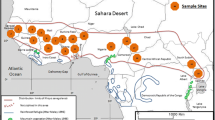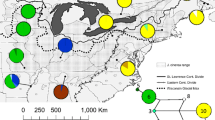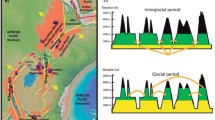Abstract
The location and definition of Pleistocene refugia for tropical forest assemblages remains controversial. Phylogeographic methods have been used successfully in temperate ecosystems to locate past forest refugia using genetic data that coincide with pollen core evidence, and in some cases provide the sole basis for their location. Here we present molecular phylogeographic data from nuclear and chloroplast loci for the forest tree Irvingia gabonensis, across the majority of its natural range, in Nigeria, Cameroon and Gabon. It is the first detailed phylogeographic study to posit the location of tropical forest refugia across this region of Africa. Using the same method of restriction fragment length polymorphism screening, 17 alleles were identified across five anonymous nuclear loci and two haplotypes at a single chloroplast locus. Analysis based on nuclear variation identified two genetically diverse, differentiated allelic clusters within the species range, one in southern Nigeria/western Cameroon and the other in southwestern Cameroon. Molecular data are consistent with a historical genetic contraction and bottleneck into these regions in the Pleistocene and/or Holocene, which has been followed by subsequent expansion. Both genetic refugia are located within areas previously suggested as forest refugia from biogeographic studies, supported by available pollen core data, and occur either side of the Sanaga River, a notable biogeographic divide for mammals (particularly primates). Other putative refugia in Gabon do not appear to have acted as genetic refugia for I. gabonensis, and Gabon was most likely recolonised from the SW Cameroon refugial source. In this study, nuclear loci were able to highlight significant phylogeographic structure across the range of a tropical African tree, whereas chloroplast analysis gave a much more limited picture. With the increased availability of sequence data for non-model species, the de novo development and further application of nuclear loci is strongly recommended for phylogeographic studies of plants.




Similar content being viewed by others
References
Aitken SN, Yeaman S, Holliday JA, Wang T, Curtis-McLane S (2008) Adaptation, migration or extirpation: climate change outcomes for tree populations. Evol Appl 1:95–111
Anthony NM, Johnson-Bawe M, Jeffery K, Clifford SL, Abernethy KA, Tutin CE, Lahm SA, White LJT, Utley JF, Wickings EJ, Bruford MW (2007) The role of Pleistocene refugia and rivers in shaping gorilla genetic diversity in central Africa. Proc Natl Acad Sci USA 104:20432–20436
Bennett KD, Provan J (2008) What do we mean by ‘refugia’? Quatern Sci Rev 27:2449–2455
Bush MB, De Oliveira PE, Colinvaux PA, Miller MC, Moreno JE (2004) Amazonian paleoecological histories: one hill, three watersheds. Palaeogeogr Palaeoclimatol Palaeoecol 214:359–393
Cavers S, Navarro C, Lowe AJ (2003) Chloroplast DNA phylogeography reveals colonisation history of a Neotropical tree, Cedrela odorata L., in Mesoamerica. Mol Ecol 12:1451–1460
Colinvaux PA, De Oliveira PE, Moreno JE, Miller MC, Bush MB (1996) A long pollen record from lowland Amazonia: forest and cooling in glacial times. Science 274:85–88
Colinvaux PA, De Oliveira PE, Bush MB (2000) Amazonian and neotropical plant communities on glacial time-scales: the failure of the aridity and refuge hypotheses. Quatern Sci Rev 19:141–169
Colinvaux PA, Irion G, Räsänen ME, Bush MB, Nunes de Mello JAS (2001) A paradigm to be discarded: geological and paleoecological data falsify the HAFFER & PRANCE refuge hypothesis of Amazonian speciation. Amazoniana 16:609–646
Colyn M, Gautier-Hion A, Verheyen W (1991) A reappraisal of palaeoenvironmental history in Central Africa: evidence for a major fluvial refuge in the Zaire Basin. J Biogeogr 18:403–407
Comes HP, Kadereit JW (1998) The effect of Quarternary climatic changes on plant distribution and evolution. Trends Plant Sci 3:432–438
Comps B, Gömöry D, Letouzey J, Thiébaut B, Petit RJ (2001) Diverging trends between heterozygosity and allelic richness during postglacial colonization in the European beech. Genetics 157:389–97
Connor EF (1986) The role of Pleistocene forest refugia in the evolution and biogeography of tropical biotas. Trends Ecol Evol 1:165–168
Dauby G, Duminil J, Heuertz M, Hardy OJ (2010) Chloroplast DNA polymorphism and phylogeography of a Central African tree species widespread in mature rainforests: Greenwayodendron suaveolens (Annonaceae). Tropical Plant Biology 3(1):4–13
Dawson IK, Hollingsworth PM, Doyle JJ, Kresovich S, Weber JC, Montes CS, Pennington TD, Pennington RT (2008) Origins and genetic conservation of tropical trees in agroforestry systems: a case study from the Peruvian Amazon. Conservation Genetics 9:361–372
De Block P (1998) The African species of Ixora (Rubiaceae-Pavetteae). Opera Bot Belg 9:1–218
Degen B, Petit R, Kremer A (2001) SGS—Spatial Genetic Software: a computer program for analysis of spatial genetic and phenotypic structures of individuals and populations. J Heredity 92:447–448
Demesure B, Sodzi N, Petit RJ (1995) A set of universal primers for amplification of polymorphic non-coding regions of mitochondrial and chloroplast DNA in plants. Mol Ecol 4:129–131
Dick CW, Bermingham E, Lemes M, Gribel R (2007) Extreme long distance dispersal of the lowland rainforest tree Ceiba pentandra L. (Malvaceae) in Africa and the Neotropics. Mol Ecol 16:3039–3049
Dick CW, Jones FA, Hardy OJ, Petit R (2008) Spatial scales of seed and pollen-mediated gene flow in tropical forest trees. Tropical Plant Biology 1:20–33
Dutech C, Maggia L, Tardy C, Joly HI, Jarne P (2003) Tracking a genetic signal of extinction recolonization events in a Neotropical tree species: Vouacapoua americana Aublet in French Guiana. Evolution 57:2753–2764
Elenga H et al (2000) Pollen-based biome reconstruction for southern Europe and Africa 18,000 yr BP. J Biogeogr 27:621–634
Fontaine C, Lovett PN, Sanou H, Maley J, Bouvet J-M (2004) Genetic diversity of the shea tree (Vitellaria paradoxa C.F. Gaertn), detected by RAPD and chloroplast microsatellite markers. Heredity 93:639–648
Gentry AH (1992) Tropical forest biodiversity: distributional patterns and their conservational significance. Oikos 63:19–28
Grubb P (1978) Patterns of Speciation in African Mammals. Bull Carnegie Mus Natur Hist 6:152–167
Haffer J (1969) Speciation in Amazonian forest birds. Science 165:131–137
Hamrick JL, Godt MJW, Sherman-Broyles SL (1992) Factors influencing levels of genetic diversity in woody plant species. New Forest 6:95–124
Harris DJ (1996) A revision of the Irvingiaceae in Africa. Bull Jard Bot Nat Belg 65:143–196
Heuertz M, Fineschi S, Anzidei M, Pastorelli R, Salvini D, Paule L, Frascaria-Lacoste N, Hardy OJ, Vekemans X, Vendramin GG (2004a) Chloroplast DNA variation and postglacial recolonization of common ash (Fraxinus excelsior L.) in Europe. Mol Ecol 13:3437–3452
Heuertz M, Hausman JF, Hardy OJ, Vendramin GG, Frascaria-Lacoste N, Vekemans X (2004b) Nuclear microsatellites reveal contrasting patterns of genetic structure between western and southeastern European populations of the common ash (Fraxinus excelsior L.). Evolution 58:976–988
Hewitt GM (1999) Post-glacial re-colonization of European biota. Biol J Linn Soc 68:87–112
Hewitt GM (2000) The genetic legacy of the Quaternary ice ages. Nature 40:907–913
Jamnadass R, Hanson J, Poole J, Hanotte O, Simons TJ, Dawson IK (2005) High differentiation among populations of the woody legume Sesbania sesban in sub-Saharan Africa: implications for conservation and cultivation during germplasm introduction into agroforestry systems. For Ecol Manag 210:225–238
Jamnadass R, Lowe AJ, Dawson IK (2009) Molecular markers and the management of tropical trees: the case of indigenous fruits. Tropical Plant Biology 2:1–12
Jolly D, Harrison SP, Damnati B, Bonnefille R (1998) Simulated climate and biomes of Africa during the late quarternary: comparison with pollen and lake status data. Quatern Sci Rev 17:629–657
Lemes MR, Dick CW, Navarro C, Lowe AJ, Cavers S, Gribel R (2010) Chloroplast DNA microsatellites reveal contrasting phylogeographic structure in mahogany (Swietenia macrophylla King, Meliaceae) from Amazonia and Central America. Tropical Plant Biology 3(1):40–49
Lowe AJ, Russell JR, Powell W, Dawson IK (1998) Identification and characterization of nuclear, cleaved amplified polymorphic sequences (CAPS) loci in Irvingia gabonensis and I. wombolu, indigenous fruit trees of west and central Africa. Mol Ecol 7:1771–1788
Lowe AJ, Wilson J, Gillies ACM, Dawson I (2000) Conservation genetics of bush mango from central/west Africa, implications from RAPD analysis. Mol Ecol 9:831–841
Maley J (1996) In: van der Maesen LJG et al (eds) Biodiversity of African plants. Kluwer, The Netherlands, pp 519–535
Maley J (2002) A catastrophic destruction of African forests about 2,500 years ago still exerts a major influence on present vegetation formations. IDS Bulletin-Institute of Development Studies 33:13
Maley J, Brenac P (1998) Vegetation dynamics, palaeoenvironments and climatic changes in the forests of western Cameroon during the last 28000 years B.P. Rev Palaeobot Palynol 99:157–187
Muchugi A, Lengkeek AG, Kadu CAC, Muluvi GM, Njagi ENM, Dawson IK (2006) Genetic variation in the threatened medicinal tree Prunus africana in Cameroon and Kenya: implications for current management and evolutionary history. S Afr J Bot 72:498–506
Muloko-Ntoutoume N, Petit RJ, White L, Abernethy K (2000) Chloroplast DNA variation in a rainforest tree (Aucoumea klaineana, Burseraceae) in Gabon. Mol Ecol 9:359–363
Newton AC, Allnutt T, Gillies ACM, Lowe AJ, Ennos RA (1999) Molecular phylogeography, intraspecific variation and the conservation of tree species. Trends Ecol Evol 14:140–145
Petit RJ et al (2002a) Chloroplast DNA variation in European white oaks: phylogeography and patterns of diversity based on data from over 2,600 populations. For Ecol Manag 156:5–26
Petit RJ et al (2002b) Identification of refugia and post-glacial colonisation routes of European white oaks based on chloroplast DNA and fossil pollen evidence. For Ecol Manag 156:49–74
Petit RJ, Aguinagalde I, de Beaulieu J-L, Bittkau C, Brewer S, Cheddadi R, Ennos R, Fineschi S, Grivet D, Lascoux M, Mohanty A, Müller-Starck G, Demesure-Musch B, Palmé A, Martín JP, Rendell S, Vendramin GG (2003) Glacial refugia: hotspots but not melting pots of genetic diversity. Science 300:1563–5
Prentis PJ, Sigg DP, Raghu S, Dhileepan K, Lowe AJ (2009) Understanding invasion history: genetic structure and diversity of two globally invasive plants and implications for their management. Divers Distrib 15:822–830
Provan J, Powell W, Hollingsworth PM (2001) Chloroplast microsatellites: new tools for studies in plant ecology and evolution. Trends Ecol Evol 16:142–147
Reynaud-Farrera I, Maley J, Wirrmann D (1996) Végétation et climat dans les forêts du Sud-Ouest Cameroun depuis 4770 ans BP: analyse pollinique des sédiments du Lac Ossa. CR Acad Sci Paris 322(Série II):749–755
Schaal BA, Hayworth DA, Olsen KM, Rauscher JT, Smith WA (1998) Phylogeographic studies in plants: problems and prospects. Mol Ecol 7:465–474
Sosef MSM (1994) Studies in Begoniaceae (thesis, Univ. Wageningen Agric. Univ. Papers), 5:133-148
Taberlet P, Gielly L, Pautou G, Bouvet J (1991) Universal primers for amplification of three non-coding regions of chloroplast DNA. Plant Mol Biol 17:1105–1109
Tsy JMLP, Lumaret R, Mayne D, Vall AOM, Abutaba YIM, Sagna M, Raoseta SOR, Danthu P (2009) Chloroplast DNA phylogeography suggests a West African centre of origin for the baobab, Adansonia digitata L. (Bombacoideae, Malvaceae). Mol Ecol 18:1707–1715
Villiers JF (1996) Les Legumineuses Mimosoidees ombrophiles de basse altitude africaines et malgaches: biodiversite et repartition. In: van der Maesen LJG et al (eds) The biodiversity of African plants. Kluwer, Netherlands, pp 602–611
Vincens A, Schwartz D, Bertaux J, Elenga H, de Namur C (1998) Late Holocene climatic changes in Western Equatorial Africa inferred from pollen from Lake Sinnda, Southern Congo. Quatern Res 50:34–45
Wang J, Gao P, Kang M, Lowe A, Huang H (2009) Refugia within refugia: the case study of a canopy tree Eurycorymbus cavaleriei in subtropical China. J Biogeogr 36:2156–2164
White F (1993) Refuge theory, ice-age aridity and the history of tropical biotas: an essay in plant geography. Fragm Flor Geobot Suppl 2:385–409
Willis KJ, Whittaker RJ (2000) The refugial debate. Science 287:1406–1407
Yeh FC, Yang R-C, Boyle T (1999) Popgene Ver. 1.31. University of Alberta, Alberta
Zanetto A, Kremer A (1995) Geographical structure of gene diversity in Quercus petraea (Matt.) Liebl. I. Monolocus patterns of variation. Heredity 75:506–517
Acknowledgements
We wish to thank Pete Hollingsworth, Jean Maley, Adrian Newton, Toby Pennington, Roger Leakey, Julia Wilson and Melvin Cannell and two anonymous reviewers for reviews of and constructive comments to the manuscript. The work was funded jointly by Natural Environment Research Council, Edinburgh Centre for Tropical Forests and the World Agroforestry Centre.
Author information
Authors and Affiliations
Corresponding author
Additional information
Communicated by Christopher Dick
Rights and permissions
About this article
Cite this article
Lowe, A.J., Harris, D., Dormontt, E. et al. Testing Putative African Tropical Forest Refugia Using Chloroplast and Nuclear DNA Phylogeography. Tropical Plant Biol. 3, 50–58 (2010). https://doi.org/10.1007/s12042-010-9045-2
Received:
Accepted:
Published:
Issue Date:
DOI: https://doi.org/10.1007/s12042-010-9045-2




